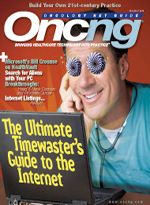Searching for Aliens with Your Idle Computer
Since this is the fun issue, I decided to take an off beat look at what your office computers could be doing while you are not using them. The concept of donating idle computer time to science projects has been around since the dawn of the Internet.
Since this is the “fun” issue, I decided to take an off beat look at what your office computers could be doing while you’re not using them. The concept of donating idle computer time to science projects has been around since the dawn of the Internet.
Here’s how it works: your computer sits idle most of the time, using only a fraction of its total processing power, even when you are using it. For example, as I write this article, every time I stop typing my computer wastes millions of free computing
cycles that could be spent doing something else. Even more idle time slices are available each time I go see a patient or take a break.
Harnessing the processing power of the millions of computers linked together over the Internet would create more computing power than a supercomputer, at a tiny fraction of the cost. Many scientific projects that require huge amounts of data to be analyzed could benefit by harnessing the enormous unused processing power of all our computers. Luckily this can be done with little difficulty, because the software used to accomplish this runs in the background when your computer is not doing anything important and hence doesn’t significantly affect computer performance.
The SETI@home project is one of the largest and best known of these eff orts to use idle computer cycles. Based at the University of California, Berkeley’s Space Sciences Laboratory, SETI (Search for Extraterrestrial Life) is the longest-running search for radio signals from alien civilizations. It uses desktop computers to help crunch the myriad of data pouring in from big radio-telescopes. According to the project’s website, it has signed up more than five million volunteers and boasts the largest community of users of any Internet computing project.
Another cool project is ClimatePrediction.net, the largest experiment to try to produce a forecast of the climate in the 21st century. Th e project utilizes hundreds of thousands of stateof- the-art climate models with slightly different physics in order to represent the entire range of uncertainties in all the parameterizations. This technique, known as ensemble forecasting, requires an enormous amount of computing power, far beyond the currently available resources of cutting-edge supercomputers. The only practical solution is to combine the power of thousands of ordinary computers, each computer tackling one small but key part of the problem.
For those of us in the medical profession, donating idle computer time to help find potential cures and treatments for disease is a natural fit. World Community Grid’s mission is “to create the largest public computing grid benefiting humanity.” Active research projects include Help Conquer Cancer, which aims to improve the results of protein x-ray crystallography, helping researchers not only annotate unknown parts of the human proteome, but also improving their understanding of cancer
initiation, progression, and treatment. Other projects include research on AIDS, muscular dystrophy, HCV, and dengue.
To facilitate scientific access to the Internet’s computers, the Berkeley Open Infrastructure for Network Computing (BOINC) provides free open-source software that can be downloaded and easily installed. Once this is done, you enter the URL of the project to which you want to donate your idle computer time. For a list of popular projects to which you can contribute, check out http://boinc.berkeley.edu/projects.php. Most of the projects seem reasonable, and the tough part is figuring
out which one you want to support. Personally, I’m torn between SETI and Einstein@Home, which searches for spinning neutron stars that create gravity waves and may help prove Einstein’s Special Theory of Relativity. There are many options depending on what you’re in to, such as the Riesel Sieve group, which is finding prime numbers of the form k*2n-1.
These projects are independent. Some are based at universities and research labs, while others are run by companies and individuals. When you participate in a project, you entrust it with your computer’s security and data privacy. In deciding whether to join a research project, carefully read its website and ask yourself these questions:
• Does it clearly describe goals that are important and beneficial?
• Will its applications damage your computer or violate your privacy?
• Who owns the results of the computation?
• Will they be freely available to the public or will they belong to a for-profit business?
Finally, remember that donating your idle computer time should not encourage you to leave your computer(s) on overnight or for extended periods of non-use. You should continue to power down your systems is usual to help reduce the burning of fossil fuels for electricity, lest we add to our climate problems while looking for its solution.
Dr. Bertman is Physician Editor-in-Chief of MDNG: Primary Care/Cardiology Edition. He is also a Clinical Assistant Professor of Family Medicine at Brown University and president of AmazingCharts.com, a leading developer of electronic health record (EHR) software. He also is the founder and president of AfraidToAsk.com, a consumer website focusing on personal medical topics. He is in private practice in Hope Valley, RI.




